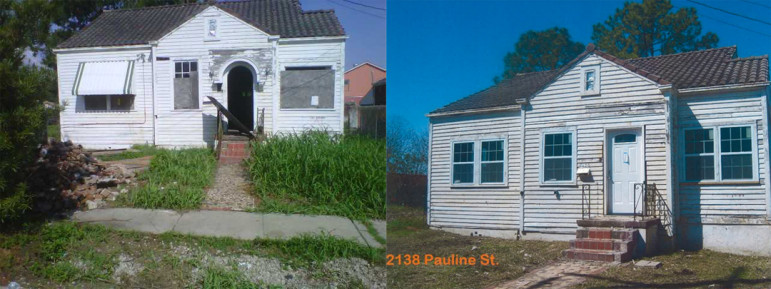Poor communication and sloppy case management contributed to the surprise demolition of postal worker Kim James’ home on Pauline Street in the Upper 9th Ward.
In August, The Lens wrote about the James family and their efforts to renovate their home in the wake of Hurricane Katrina.
After years of wrestling with the tangle of recovery grants administered by the state’s Road Home program, in 2012 James finally secured the funds to repair her house.
A contractor was working on the interior and had installed new windows when, in July, James found out the city had demolished the place as part of its blight-eradication campaign.

Delving into communications between a state employee who coordinated Road Home recovery grants and the city code enforcement official who ordered the demolition, carelessness is revealed on both sides.
On May 14, Pura Bascos, director of the office of Code Enforcement, fired off an email to Marisa Robertson, who works in the Disaster Recovery Unit of the state Office of Community Development.
Audio: The Lens’ Karen Gadbois discusses zoning and blight enforcement with WWNO’s Eve Troeh
Bascos’ note is terse in the extreme. The subject line reads: “state matches for SDER properties,” a reference to Strategic Demolition for Economic Recovery, a city-run program aimed at reducing blight.
The rest of Bascos’ email is a fateful three words long: “2138 Pauline? Status?”
Bascos had directed her inquiry to the right official. According to Angela Vanveckhoven, communications manager with the state’s Office of Community Development, Robertson is “tasked with providing the City of New Orleans’ Code Enforcement Department with information concerning homeowners’ pending funding from both the Road Home and Hazard Mitigation Grant programs.”
In response, Robertson correctly informed Bascos that the property had been declared ineligible for funding under the Hazard Mitigation Grant Program. Robertson reminded Bascos that she had informed her of that a year ago, when she said that the city could release its “hold” for demolition of the house.
But what she did not say — fatal to James’ dream of restoring the house — was that the house was a recipient of a different Road Home program.
Doing so would have clarified the fact that James had secured a $52,000 grant under the Road Home’s blight eradication program to do the repairs — work that was ongoing at the time.
Efforts by The Lens to contact Robertson for comment were unsuccessful.
Bascos also declined to comment, but city spokesman Tyler Gamble says the city followed procedure by checking with the state about the property. He said the city had held off on the demolition of the Pauline Street house for a year because the state said James was being considered for the Hazard Mitigation Grant Program.
When the State informed the city in May 2013 that the homeowner was no longer in the pipeline to get HMGP funding, and once it became clear that no significant work had been done on the property since the City’s last inspection, the City moved forward with the demolition.
Ceisha James-Hayes, Kim James’ daughter, rejected the city’s argument, noting that the photos provided by the city show that new windows had been installed. And despite numerous calls to the city, she has not received documentation beyond those photos, such as an inspection report, to show how the office of Code Enforcement reached its conclusion.
The state’s position: Regardless of what Robertson told Bascos in May, the state had informed the city in 2012 about the $52,000 grant to fix up the house. After the house had been torn down, Vanveckhoven told James-Hayes by email:
The City was notified that your mother received the Blight Reduction Grant funds through the Road Home program in 2012, and the City was notified in May 2013 that your mother was no longer in the pipeline to receive funds through the Hazard Mitigation Grant program.
Either way, no one notified Kim James that her house was set for demolition. Now her house is history and the family’s plans to return to New Orleans are on hold.
